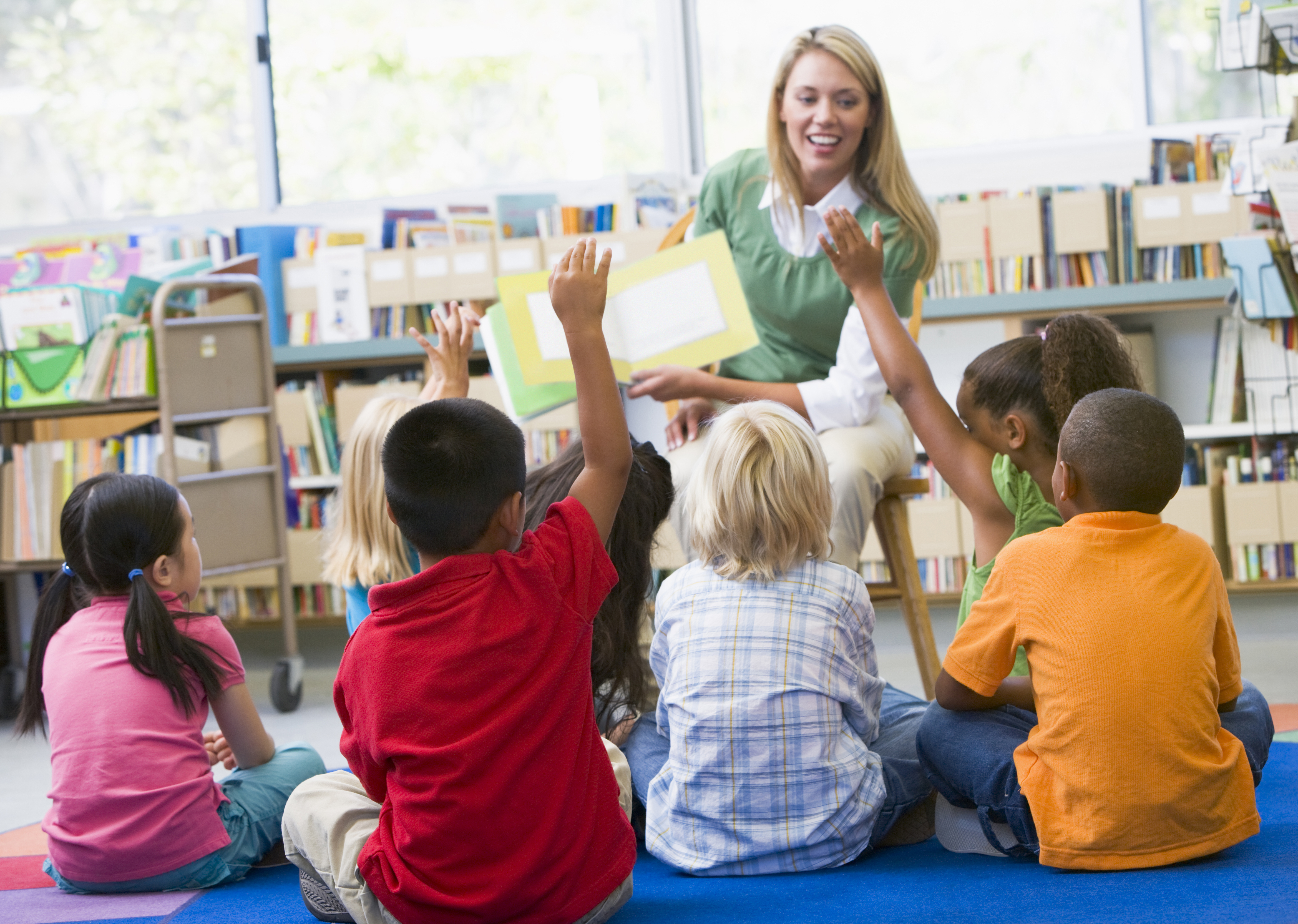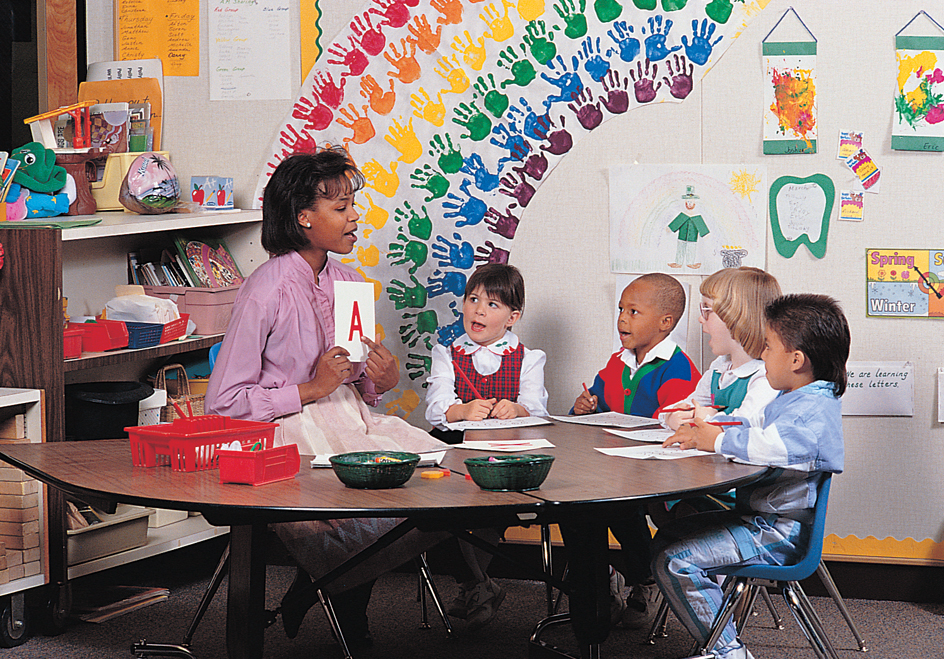Kindergarten is the school grade before first grade. Most kindergarten children are 5 or 6 years old. They spend several hours each day with a teacher who helps them learn through playing and other activities. Kindergarten activities may involve art, music, language arts, science, and social studies. The teacher also helps the children work together as a group. Some kindergartens offer formal instruction in reading and writing. German educator Friedrich Fröbel created the word kindergarten in the mid-1800’s. The name comes from two German words that mean garden of children.
Kindergarten activities
Kindergartens provide activities designed to increase a child’s confidence, to encourage learning and creative expression, and to develop the ability to work in groups.
Formal group activities
offer organized, shared experiences for all the children in a class. Such activities should be enjoyable and interesting. They also help children learn to adjust their own plans to those of others.

Kindergarten days often begin with a discussion time. This period gives each child a chance to report interesting experiences to other children. Taking turns and being quiet while others speak help children develop self-control. In many kindergartens, each child has a special daily assignment to do for the group. Such tasks might include watering plants or helping serve a snack.
In most classrooms, children participate in group reading of oversized books that feature illustrated stories, poems, or songs. These books have an easy-to-read vocabulary and print that is large enough for a group of children to see. Other group events help children understand numbers with such exercises as counting, measuring, and matching quantities.
Many group activities involve projects in which children explore their schools, neighborhoods, or communities. Such projects might include learning about the people who work in a school or studying a nearby building under construction or visiting a post office, farm, zoo, or museum. After the children return to school, they engage in classroom activities that deepen their understanding of their experience. The students may compose stories about their trip, make models of buildings or animals they saw, or dramatize events with puppets. The teacher may read stories or show videotapes about the project.
Other shared activities include a music time in which children sing, dance, or listen as a group. Many days include indoor or outdoor organized games.
Informal group and individual activities.
When the class is not involved in a formal group experience, kindergarten children are free to choose many of their activities. Making choices encourages the personality development of each child. Children learn to work in their own way and to recognize and appreciate their own abilities and those of others. Most kindergartens permit children to talk freely and to share ideas and feelings during informal activities.
Kindergarten children differ from one another in their readiness to work in informal groups. They feel comfortable in groups of different sizes. They also have different interests. Some children are eager to learn to read, write, or count. Other children prefer pretending, building, or painting. The best kindergartens provide activities and materials that engage and challenge all children.
The room and the equipment
The kindergarten room
should be big enough for children to move freely and not feel crowded. A big room also provides an area for activities, such as building or pretending, that require a large space.
Such features as pets or plants make the room attractive and interesting and help children feel at home. Most kindergartens have special child-sized tables, chairs, washbasins, and toilets. Many kindergarten rooms are on the ground floor of a school so the children can exit quickly in the event of a fire or other disaster.
Equipment
in a kindergarten provides opportunities for play and creative expression. Some equipment helps children develop skill in handling or manipulating materials. Standard supplies include puzzles and other toys; blocks of different sizes, shapes, and colors; objects that can be arranged according to size or pattern; and alphabet and number games. Most kindergartens also have miniature houses, cars, dolls, and animals. Some schools may have a workbench with real tools, where carefully supervised children are taught to sand wood, use a saw, and hammer nails. Art materials include paints and brushes, easels, fingerpaints, crayons, markers, colored pencils, and clay.
Dramatic play is an important part of the program. The room may include a center for imagining and pretending that provides clothing, equipment, and child-sized models of appliances and furnishings. Additional centers may resemble familiar areas outside the home, such as a grocery store or office.
Music plays a big part in many kindergartens. Some rooms have a piano, and most have a cassette tape player or compact disc (CD) player. The children learn or create songs and sing them with the teacher. They beat rhythms with drums, cymbals, and triangles.
Most kindergartens have a variety of books. Teachers read stories to the children and show them pictures from the books. Later, the children may examine the books alone while they recite parts they have memorized during the teacher’s presentation. For many children, such recitation is a first step in learning to read.
Many kindergartens have a chalkboard. Teachers can help make words familiar by writing on the board as they discuss assignments, activities, or events. Some rooms have computers and software that enables kindergartners to practice reading and writing.
A kindergarten may have its own outdoor play space with large climbing structures and other equipment. Youngsters develop their physical skills and coordination by climbing, running, and taking part in other active play. Kindergartners also enjoy pretending that play structures are airplanes, cars, or spaceships.
The kindergarten teacher
A good kindergarten teacher enjoys working with young children. Such work requires great patience and the ability to understand children’s concerns and to talk with children on their own level. Teachers help children meet the challenges of kindergarten by providing many kinds of support and guidance. Kindergartners may need help playing and working in a group, putting on boots and jackets, or developing good health habits. One of the most important ways in which teachers help kindergartners is by encouraging independence.

At the same time, teachers help create close ties with children’s homes. Teachers talk with parents about their child’s development throughout the year. A teacher may visit a child’s home, and parents may visit the class. Many kindergartens also hold group meetings for parents. Sometimes, parents assist the kindergarten teacher by helping with activities in and out of the classroom.
In most states of the United States, kindergarten teachers need a four-year teaching degree. In most Canadian provinces, they need a three- or four-year degree followed by an additional year leading to certification. Many states now offer a specialized teaching license that qualifies a person to work with young children in preschool through third grade.
History
Early kindergartens.
Friedrich Fröbel, the founder of the kindergarten movement, started his first kindergarten in Blankenburg, Germany, in 1837. Other educators had established schools for educating young children. But Fröbel invented the term kindergarten, which means garden of children in German. Fröbel believed that children’s minds and spirits grow naturally in the proper environment, much as plants grow freely in a garden. Fröbel devoted much of his life to designing methods and materials that would encourage this natural growth. Many of the materials that he developed remained standard kindergarten equipment for years.
Before Fröbel established his kindergarten, the social reformer Robert Owen had set up infant schools at New Lanark, Scotland, and New Harmony, Indiana. Owen believed that teaching children good behavior and moral attitudes would help create an ideal society.
Margaretha Meyer Schurz, a student of Fröbel’s in Germany, established the first kindergarten in the United States in 1856. In her Watertown, Wisconsin, home, she started a German-speaking school for her children and the children of her relatives. Some neighbors soon asked if their children could join. Schurz expanded her kindergarten to include other children of the community and moved the class to a small vacant building.
Elizabeth P. Peabody, a teacher and author, started an English-speaking kindergarten in Boston in 1860. The first public kindergarten opened in the St. Louis, Missouri, school system in 1873. The first public kindergarten in Canada was established in Ontario in 1871.
The first kindergartens served children from both low-income and wealthy homes. Many early public school kindergartens were privately funded by charities. These kindergartens tried to provide good experiences for children as young as 3 years old. They also tried to improve home conditions. Teachers spent almost half their time giving families the types of assistance that social workers today provide. Such assistance might include advice about child care, health, or housing.
During the 1900’s, more and more communities recognized the value of kindergarten programs. As a result, the kindergarten movement continued to spread to smaller cities, towns, and rural areas. Teacher-training schools gave increased attention to training kindergarten teachers. Many communities provided funds for enriching their teaching programs.
Kindergartens today
face several challenges. Class size is a major issue for many communities. The National Association for the Education of Young Children recommends that classes for 5-year-olds consist of no more than 15 students. The association is the largest organization in the United States of teachers and directors of preschools, kindergartens, and elementary schools. Budget limits, however, force many schools to place 25 or more students in each class. Large classes make it hard for teachers to meet individual students’ needs.
Budget limits also affect kindergarten schedules. Traditionally, kindergarten was a half-day program. Half the students in a school district attended in the morning, and the other half went to school in the afternoon. Many parents and educators now favor a full-day kindergarten program. But some communities do not have the resources to provide full-day kindergarten. Such programs require twice as many teachers, classrooms, and materials as do half-day programs.
Many communities also debate how best to meet the needs of an increasingly diverse group of students. Many 5-year-olds have some type of preschool education before they reach kindergarten. Some people therefore feel that kindergartners are ready for formal instruction in reading, arithmetic, and other academic subjects. But such instruction may be premature for students who come to kindergarten with no preschool experience.
Because of immigration, many communities have students from a variety of countries and cultures. Some of these students do not speak the local language and must learn it when they start school. Such students would have difficulty understanding formal lessons given in a language they have not yet mastered. Most experts feel that informal learning provides a better opportunity to meet the needs of all kindergartners than does formal instruction.
Another debate concerns the best age for students to start kindergarten. Many public schools determine eligibility for kindergarten by setting a date by which an entering student must reach 5 years of age. Some parents feel children who are ready should attend kindergarten before they reach 5. Other families want to postpone enrollment while a child matures physically or intellectually. Some kindergartens are experimenting with flexible kindergarten entrance dates and multi-age groupings. Such a grouping might include children ages 4 and 5 in the same classroom.
